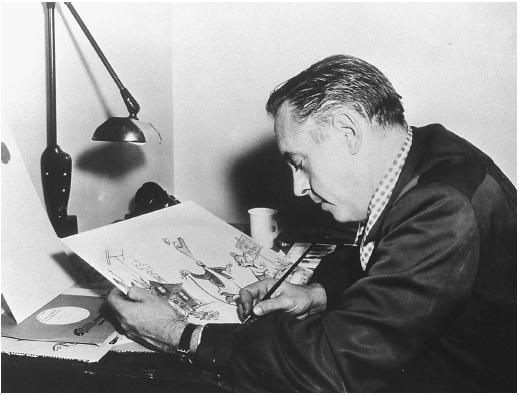Frank Tashlin was the nut-case genius who unleashed
the nut-case genius of Jerry Lewis as a filmmaker. Before Lewis became
a director, Tashlin directed him in some important movies that helped
set the tone and strategy for Lewis' later work.
Tashlin basically showed Lewis that if in a film you
deconstructed the process of making movies and let the audience in on
the deconstruction in a lighthearted, complicitous way, you could
vastly expand the range of comic eccentricity possible in a mainstream
film. As long as the audience knew you were violating convention
deliberately and “just for laffs” it would then allow you to do and say
almost anything.

Tashlin started out in animation, so he had a good
idea of how much surrealism and aesthetic self-reflexiveness a
mainstream audience would accept. It was his genius to show how this
receptivity could be appealed to in live-action comedy.
The Girl Can't Help It, Tashlin's masterpiece,
starts out in black and white and in Academy ratio. Tom Ewell, the
male star of the film, steps forward towards the camera and announces
directly to the audience that the film they're about to see is in
Cinemascope. He waves his hands and the sides of the image expand to a
Cinemascope ratio. He also announces that the film will be in color —
more prestidigitation and the image becomes saturated with color.
“Sometimes,” he confides to the audience, “you wonder who's minding the
shop.”
Instantly Tashlin establishes a bond with the audience
based on the suggestion that the powers that be in Hollywood would give their customers
less than they wanted if they could get away with it — but Ewell, acting
on the audience's behalf, won't let the industry get away with it. The
implications of this are profound. Hollywood is the establishment,
part of the cultural compact of the nation. Once you're seduced into
suspecting Hollywood, you're ready to suspect everything.
But Tashlin doesn't leave it at that. As Ewell
chatters on, telling us that this movie is going to be about rock and
roll, Tashlin tracks in on a jukebox playing the title song, sung by
the highly suspect cultural icon Little Richard, and the song drowns
out the end of Ewell's monologue. Don't even trust the star, Tashlin
seems to be saying — don't even trust me.
I think it's probably a mistake to parse this film, and
Tashlin's work in general, looking for a programmatic critique of
movies or of American culture. Tashlin, like Nietzsche, is offering a
perspective from which a critique is possible, but he leaves the
conclusions to the viewer. Tashlin was interested in creating a
transgressive frame of mind, a frame of mind in which anything and
everything could be questioned — he wasn't interested in formulating
answers to the questions themselves. He liked, I think, the giddiness
of abandoning, of shattering received forms, the license it gave him to
free-associate — and that's what he does in this film.
The center of The Girl Can't Help It is the
iconic, cartoon-like image of Jayne Mansfield. Somehow Tashlin sensed
that the psychic chaos that could be induced by her sheer carnality was
somehow connected to the energy of rock and roll — that there was a
cultural matrix that generated both. There are times in the film when
he seems to be mocking this matrix, times when he seems to be
celebrating it. In fact he was just observing it in wonder — and
asking the audience to wonder about it, too.
There's a famous scene in which Mansfield bursts into
Ewell's apartment carrying two bottles of milk she's picked up from his
doorstep on her way in. She holds them up to her breasts like
extensions of those already preposterous attributes. On one level it's
a dirty joke. On another level it's a symbol of Mansfield's
innocence. On a deeper level it can be read as an acute analysis of
the male breast-fixation in post-WWII America — not a sexual thing at
all, at bottom, but an infantile regression, a lust for the alma
mater.
There are any number of such suggestive images in The Girl Can't Help It.
The complex ways African-Americans are presented in the film deserve an
essay of their own. One image can serve as an example — the
gorgeous African-American singer Abby Lincoln, dressed in a spectacular
sparkling evening gown, sexy and elegant, is shown on a cabaret stage lit in lurid colors . . .
singing a Gospel song. This is beyond satire, beyond surrealism
— it's an image as strange as American culture itself.
The lines of thought are never clear in Tashlin's best
work — and that's its value. In the
social currents he observed colliding and redirecting each other, echoed in the wildly clashing colors of his cinematography, Tashlin uncovered
perplexing contradictions in America culture and threw them in our
faces like so many custard pies. All we can do in response is wipe the
custard out of our eyes and wait for the next one.
His work in the Fifties was excellent spiritual
preparation for the Sixties — a cultural slapstick routine that still
challenges complacency in any form.
